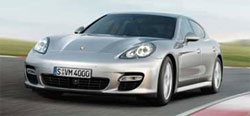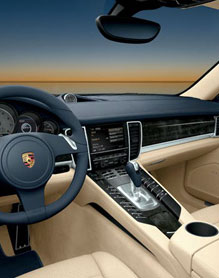2010 Porsche Panamera
It seems like the rumors of a four-door Porsche car have been dribbling out of Stuttgart for almost as long as MotorWeek‘s been on the air. Certainly, over the last three years, we’ve been fixated on every hint about the first sedan to wear the Porsche name in the firm’s 78-year history. Well, Porsche’s new flagship is no longer a rumor. This is the Panamera fastback sedan. Longer than a Cayenne SUV, it’s also the biggest Porsche ever. So, can any car this large perform like a true Porsche? Well, now’s our time to find out.
The 2010 Porsche Panamera takes its name from the legendary Carrera Panamericana race of the 1950s. While Porsche calls its first Gran Turismo a 4-door sedan, it actually has a rear hatch that makes five. But that’s only part of why Panamera’s styling is polarizing. While unmistakably Porsche, it’s on the conservative side, which should fit well-heeled sedan buyers. Frankly it also reminds us of a C6 Corvette-at the headlights, hood bulge, and even the side scoops.
With its long 115-inch wheelbase, and 195.6-inch overall length, the profile does start off coupe-like. But it becomes more tear drop towards the rear to allow for adult-sized backseat leg and headroom, something the rival Mercedes-Benz CLS lacks. The back view is wide, as if through a fish-eye lens. The hatch is well concealed, as is the retractable spoiler, with uniquely styled quad exhausts. Wheels are 18-inch standard, with optional 19’s.
 The Panamera is also the first front-engine Porsche car since the 928, driven by a pair of direct-injected V8s from the Cayenne. Panamera S and 4S use the normally-aspirated 4.8-liter with 400 horsepower and 369 pound-feet of torque. The Panamera Turbo adds twin turbochargers for 500 horses and a massive 516 pound-feet of torque.
The Panamera is also the first front-engine Porsche car since the 928, driven by a pair of direct-injected V8s from the Cayenne. Panamera S and 4S use the normally-aspirated 4.8-liter with 400 horsepower and 369 pound-feet of torque. The Panamera Turbo adds twin turbochargers for 500 horses and a massive 516 pound-feet of torque.
Gear change is Porsche’s latest 7-speed dual-clutch PDK automatic with manual paddle-shift mode. It feeds either the rear wheels of the Panamera S or all four wheels of the 4S and Turbo models. At our track, our Panamera 4S blazed from 0 to 60 in 4.9 seconds, and shot through the quarter mile in 13.5 seconds at 105 miles per hour. With Launch Control on, our car leapt out of the hole with a beastly roar. The PDK gearbox isn’t as quick as in the 911, but it’s smoother.
The Panamera’s chassis is defined by a front double-wishbone and a rear multi-link setup, all governed by Porsche’s Active Suspension Management. The adjustable dampers can be set to Normal, Sport, and suspension-lowering Sport Plus. In Sport Plus, we sliced through the cones in a razor-sharp manner. Steering response is perfect. The Panamera is a big, 4100-pound car. But that size seems to disappear the harder you push it. Our 4S also benefitted from optional Porsche Dynamic Chassis Control with its two active roll bars. Even at ridiculous speeds, cornering is flat.
Superb stopping power comes from four-wheel vented discs armed with six-piston calipers up front and four-piston in the rear. Stops averaged a very short 116 feet from 60 to zero. The Panamera just squats to a stop.
 While the Panamera’s exterior may be controversial, the interior is a feast for the eyes. Beautifully trimmed in wood and even carbon fiber, there’s plenty of space for its four adult-wide seats. Your focus is drawn to two areas: the cascading 5-bezel gauge cluster, and a center console master control panel. There’s a lot of switches here, but they’re logically grouped. Navigation data is viewed on a large center stacked screen, and inside one of the gauges. Optional is a 17-speaker, 1000-watt Burmester stereo.
While the Panamera’s exterior may be controversial, the interior is a feast for the eyes. Beautifully trimmed in wood and even carbon fiber, there’s plenty of space for its four adult-wide seats. Your focus is drawn to two areas: the cascading 5-bezel gauge cluster, and a center console master control panel. There’s a lot of switches here, but they’re logically grouped. Navigation data is viewed on a large center stacked screen, and inside one of the gauges. Optional is a 17-speaker, 1000-watt Burmester stereo.
Rear vision is mostly blind spots, so both the available camera and front-rear parking sensors are recommended. The rear seats require little contortion to get to, and as we mentioned before, adults will find a generous space with headroom boosted further by a scalloped headliner. Amenities include adjustable vents, armrest with cup holders, and an available twin screen DVD system. Impressively practical, drop the 40/20/40 rear seats to expand luggage space from 15.7 cubic feet to a crossover-like 44.6.
Government Fuel Economy ratings for the 4S are 16 City/24 Highway on premium gas. We managed only 16.7 in mixed driving. The Panamera uses a mild hybrid-like start/stop system to shut down the engine at traffic lights.
Panamera pricing starts at $90,750 for the S, $94,750 for the 4S, and $133,550 for the Turbo. There’s no gas guzzler tax. That’s a notch above an S-Class, but comparable to an Audi S8. Naysayers can have a seat, because Porsche has done it. The 2010 Panamera is a primo luxury sedan and sports-car-for-four all rolled into one. Styling aside, this unique saloon delivers everything it promises, plus a lot more.
Specifications
- Engine: 4.8-Liter
- Horsepower: 400
- Torque: 369 Lb Feet
- 0-60 MPH: 4.9 Seconds
- 1/4 Mile: 13.5 Seconds @ 105 MPH
- 60-0 MPH: 116 Feet
- EPA: 16 MPG City/ 24 MPG Highway
- Mixed Loop: 16.7 MPG
2024 Toyota Land Cruiser
Toyota’s Go Anywhere Globetrotter Returns To U.S.
Every once in a while, we all need a reset. A time to get back to basics and prioritize the things that really matter. Well, for the Toyota Land Cruiser that time is now. So, let’s find out if that means bigger and better things for Toyota’s iconic off-roader.
The Toyota Land Cruiser’s status among the global off-road community is legendary, and it’s hard to imagine there’s any corner of the earth where a Land Cruiser hasn’t kicked up a little dust or mud. Well, 2024 sees the return of the Land Cruiser to the U.S. market after a 3-year hiatus, getting a major reset for the journey.
The reset comes mostly by no longer being based on the large three-row “300-series” chassis, but a new version of the smaller “200-series,” now known as the J250. As with the latest Tacoma, it uses the Tundra pickup’s full-size steel frame.
While the main Land Cruiser model, which goes by simply Land Cruiser, is packed full of luxury and convenience features, there is also a stripped-down model known as the 1958, honoring the first year the Land Cruiser made landfall here in North America. And it is that 1958 we have here, and we were glad to see it, as it also celebrates the original’s back-to-basics approach as a blank canvas for you to personalize as you tackle more and more adventures.
Not that it’s fully stripped down, as 8-inch touchscreen infotainment, a 7-inch full-color multi-information display, and automatic climate control are still standard. Plus, some seriously durable materials, and great heated cloth front seats that throw off some get serious 1990s Tacoma vibes.
But outside, there’s a definite lack of flashy trim and basic looking 18-inch wheels with Yokohama Geolander all-season tires; plus, big chunky bumpers and tilt-up back glass, which is a rarity that we appreciate. Though there is a little too much plastic in places that are sure to see some abuse if you do any significant off-roading.
It even feels a little rough around the edges, but for us it just adds to the rugged old-school utility vibe in a good way.
We did just that, both here in the Mid-Atlantic as well as in the California desert; and while there are some tech-forward driving aids, the actual hardware is in most cases plenty to get things done. That includes standard full-time dual-range four-wheel-drive, locking center and rear diffs, and 8.7-inches of ground clearance. A front stabilizer bar disconnect is also available to allow for increased articulation.
Who needs a V6 or even a V8 when you’ve got Toyota’s i-FORCE MAX setup at your disposal with 326 horsepower and 465 lb-ft of torque coming from a 2.4-liter turbo-four with an electric motor sandwiched between the engine and its eight-speed automatic transmission. Low speed torque delivery is impressive. It even feels a little rough around the edges, which may be a turn off to some, but for us it just adds to the rugged old-school utility vibe in a good way.
And it certainly feels quicker than an off roader needs to be, with an instant torque dump as soon as we eased on the throttle at our Mason Dixon test track; helping us get to 60 in 8.1 seconds and through the quarter-mile in 16.3 seconds at 86 mph. Considering the Land Cruiser’s terrain conquering mission, it behaved quite well in our handling course; it was plenty responsive to inputs, with less body roll than we expected and plenty of grip from the tires. The steering was light and quick but as expected didn’t provide much feel. Other than significant nosedive, braking performance was exceptional. Only 107-feet to panic stop us from 60 mph.
With the shift to the smaller size, there’s no more third row available, and cargo capacity now comes in at 46.2 cubic-feet with a max of a still healthy 82.1. Now, the best part of the Land Cruiser’s return is the entry price of $57,445. That’s about 30-grand less than what the last Land Cruiser went for back in 2021.
Whether it’s over the top fashion trends, mullets, or zombies; just when you think they’re dead, they come roaring back to life. Of course, we’re much happier to see the resurrection of this 2024 Toyota Land Cruiser than any of those things. Toyota is one brand that still recognizes the value of full-framed rugged rigs and has also acknowledged that sometimes less really is more. The Godfather of Toyota off-roading is back and better than ever.







